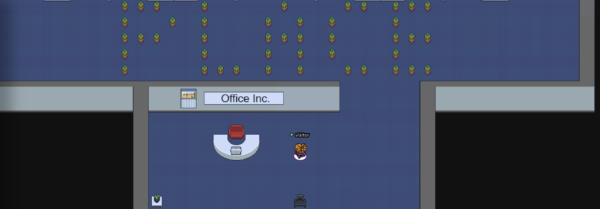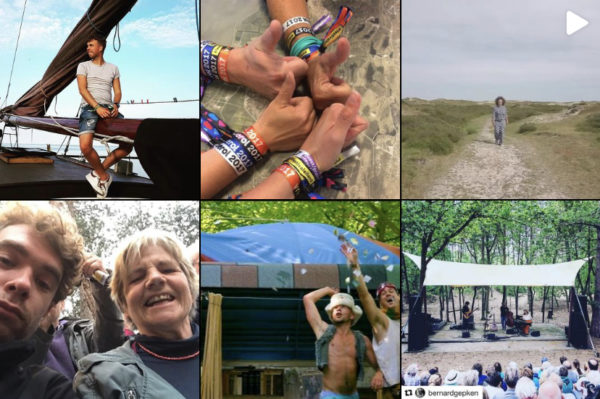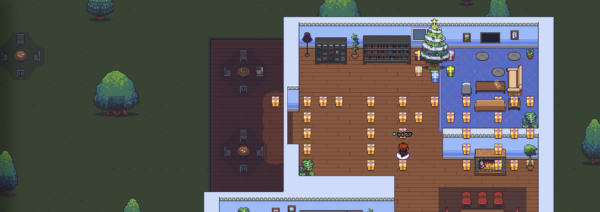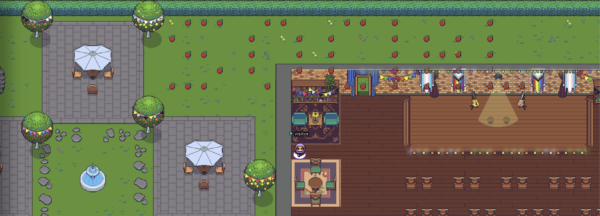When I meet on a July morning with media scientist Esther Hammelburg in Jitsi, she has been working away all night to prepare her dissertation for a test reader. For the last five years, Esther has been working on her PhD at the University of Amsterdam on the topic of ‘liveness’, which means following something remotely via media—such as our phones, televisions, and internet. Liveness encompasses different interactions: we can watch an event remotely on television or online and we can physically visit an event and tweet or post about being there. To what extent does the use of such media shape the live experience of an event?
Esther’s research, which she conducted before the COVID pandemic, included a field study at three different events: Oerol, an annual cultural festival on the Dutch island of Terschelling; Serious Request, a charity event where three radio DJs make radio 24/7 for three days from a glass house somewhere in the Netherlands; and Pride Amsterdam, a nine-day celebration of diversity in Amsterdam, with the Canal Parade as the peak of the festival. Esther visited and observed all three festivals, and interviewed nearly 400 people who were either physically and remotely present at the events. In addition, she collected tweets and Instagram posts about the festivals.
I wanted to talk to Esther because, through her research, she has a lot of knowledge about what the essence is of attending an event. What makes an audience feel part of the event? By dissecting the different elements that make up a live experience it’s easier for us, as organisers of events, to free ourselves from the habits and structures of physical events and really experiment with new, hybrid forms.
Esther’s research led to three core insights. First, how we experience ‘liveness’ changes over time. The experience is determined by the context in which it has been achieved, and twenty years ago that was different from today. Secondly, liveness is often emphasised as a feeling of ‘now’, but according to Esther three elements are important to get this feeling: time, place, and the social bonds. A live event is about a sense of ‘we are here together now’. Her third insight is that it is important to bring the physical and the mediated environment in line with one another. On the boat towards Terschelling, visitors post photos with captions like ‘Oerol, here I come’. While it might be relegated to the borders of our phones, the Instagram environment is also an environment where people are. If people attend an event and they don’t share that on Instagram, for the Instagram environment they are not really there.
How do you ensure this alignment between the physical and the mediated space when there is no physical event space, like we experienced during the pandemic? Organisers of events are making a great mistake when they think they can simply transplant what they used to do physically into an online space. An online event is not a literal translation of an offline event. To investigate what makes a good online or hybrid event experience, it is important to once again take a look at the three elements Esther defined as necessary to get this feeling of ‘now’: time, place and the social bonds. How do you shape place? How do you shape time? And how do you give shape to the social? During our conversation Esther tells me what she learned about these elements through her research.

Place: play with the physical space of the online visitor
Lilian Stolk: As your research has shown, when people post a photo of their boat trip to Oerol on a platform like Instagram, an extra layer of spaciousness is added to the experience. It makes the experience more intense. How can this be translated to online events? How can you apply multiple layers of spaciousness when an event takes place entirely online?
Esther Hammelburg: Let’s take this conversation as an example. We’re now speaking digitally via Jitsi, but we’re both in a physical environment. It would have been a different experience if we had met in a cafe. Our physical environment always plays a role.The difference with Oerol is that Oerol primarily takes place in one specific physical environment, whereas our meeting could take place in many different spaces. I think that the physical location of visitors might play a role during online events, only this is something we have yet to learn. Thirty years ago, you wouldn’t have even thought of using your phone, by posting on an online platform, to share that you were present at a physical event. You can also add a layer of spaciousness to an online conference by tweeting about it. With conferences going online, the activity on Twitter has sometimes increased. Perhaps the need to tweet is even bigger when you’re watching a conference from your bedroom instead of being there physically. Attendees want to emphasise that they are really there.
But you also see that people consciously do not use media during events. Post-pandemic, this could also accelerate, because we are becoming tired of sitting behind screens. For a hybrid event, I can imagine that it’s nice to let people do something in their own physical environment, separated from the screen.
LS: As organisers of events, I think it’s a challenge to make an interesting event experience for both physical and virtual visitors. But instead of reinventing the wheel for a hybrid event, maybe we can fall back on technology that already exists. Maybe we can learn from other fields, like television. Did you see elements in your research that cultural organisations could learn from?
EH: Indeed, we sometimes forget that television brought forth new inventions and ideas that could now be used in different contexts. Serious Request is an event that people follow physically and via television. What I noticed during my research is that people who follow this event via television created their own physical traditions and rituals. For example, they’d curl up on the couch with a blanket and have their living room decorated with Christmas ornaments. Because Serious Request always takes place before Christmas, for many viewers that I interviewed this was part of their experience. In addition to the fact that the decorated living rooms are part of the event, people are collecting money by, for example, riding their scooter from Assen to Groningen. They share photos of their trip via social media, and sometimes their posts are also shared by the organisation. In that way this event has many physical event locations outside of the central glass house.

Place: an event can also take place in several locations at the same time
LS: It’s interesting to think about an event taking place in multiple locations. In a previous conversation we had, you gave the example of a football match. You can watch it live in a football stadium, but you can also invite a group of friends and watch it together at home. Both generate a live experience.
EH: For music performances, art gatherings, and maybe also for lecture events, it could work well to organise smaller meetings in different locations that people can come to. In the context of sustainability, more and more people don’t want to fly to the other side of the world for a three-day conference six times a year. Large conferences can also create hubs per continent or country. And if people can invite friends over to watch a football match at home, why not throw a festival party with streamed DJ music?
Place: use the platform as a ritual space
LS: I get that not understanding how a platform works can be a barrier to join an event—and this can be a reason to use a platform that people know—but it’s not like I’m going to an event in Zoom because it takes place in Zoom. For most online events you will simply receive a link in your mailbox to join an event. If you make sure the platform you use works well and is easy to understand, you can also use a platform that is new for everyone.
EH: I even think this is an added value. When you create a platform that is truly isolated from websites people regularly visit or use, it’s a new experience for people. If you broadcast your event via Facebook Live, you still send people to Facebook where a lot of people are used to doing other things. As a result, they easily get out of the flow of your event. If you want to create a ritual gathering—by that I mean that visitors follow your event with a certain dedication—I think this should take place out of peoples’ daily browsing habits. People go to a festival site. People take a boat to Terschelling. Then they can also click on a link to a platform that they do not know.

Time: creating rituals
LS: For online events, we haven’t yet developed clear rituals. Often people watch television at a certain time, and sometimes for a specific program. But we use our laptop all day long, and we’re mainly using it for things other than visiting events. Many people are now getting tired of attending online events. I totally understand that if you’ve been working behind your laptop all day, you don’t want to open it again in the evening to go to an event.
EH: Indeed. That could be different if we no longer constantly work from home. Still, there are a lot of distractions on a laptop. Now that I talk to you, I also see new e-mails popping up on my screen. The power of Oerol, which takes place on an island, is that you leave the mainland behind. Going to a festival on a physical festival site has a similar effect. Of course you can still call and check your e-mail, but for a lot of people it feels like they are gone for a while. Following an event while sitting at your kitchen table is the opposite of that.
LS: I also sign up for all kinds of online events, and only visit half of them. I’m even often doing things for work while I’m watching.
EH: Yes, it is easier to follow something on the side. Also because at online events the audience is often not visible. For that reason I always try to turn on my camera at meetings. It helps you to be aware and feel seen. An audience at physical events—even if they don’t contribute to the program—are still seen by the speaker and by other visitors. At online events, the audience can watch and listen unseen. You can even do the dishes while attending an event.
LS: Do you think rituals are necessary to have a good live experience?
EH: I think so. Rituals can ensure that people join an event with time and attention. It is very difficult to accomplish this on a laptop, at a kitchen table, without having any rituals. We’ll probably develop all kinds of solutions for this that we don’t know yet.
Time: during online events a transition time is lacking
LS: If you go to Oerol, you have to take a 2-hour boat ride. Even if you’re attending an event in the city or town where you live, you need to get ready and travel to the venue. This journey, a transition to an event, is missing at online events. To attend an online event, all you have to do is open your laptop.
EH: That transition is indeed very important. Next to the ritual, this also ensures people’s focus and attention. When I teach online, I always advise my students to turn on their camera and sit down for class, similar as they would do for a physical class. Also, sitting in a quiet and a peaceful place helps you to really experience online classes or events. In practice, people rarely do that. In my classes, but also at conferences, I see a lot of the people simultaneously checking their e-mail or homeschooling their children.
Time: taking visitors out of their rhythm
LS: With The Hmm, we have organised two tours that took place completely over the internet, The Hmm in Quarantine and The Hmm on Alternative Platforms, both with five 5-minute lectures on five different platforms. During The Hmm in Quarantine we used different presentation platforms, like YouTube, Twitch, Zoom and Jitsi. During The Hmm on Alternative Platforms we asked our audience to join talks on platforms that were alternatives to big tech platforms. Most of those platforms are not made for presentations. We had a talk in ethercalc, an open source alternative for Microsoft Excel and one in Mastodon, a decentralised social platform similar to Twitter. Because links to the next platform were sent in the chat, it ensured that the audience had to keep their attention on the program. They couldn’t do other things in the meantime. From all the online events we’ve organised so far, I think this format worked best. It engaged viewers in a different way than a simple talk and Q&A structure.
EH: What also works well with that format is that your viewers have to surrender to the rhythm of your event, and can not keep following their own rhythm. When you’re watching television on the edge of your seat, you are also taken out of your own rhythm for a while. You break your daily pattern by paying attention to something else at that moment.

Social: a personal view
LS: One of our speakers this year said that the increase in online events has given us the very unique experience of getting such a personal look into people’s home environments. During events and meetings, we see cats, partners, and children passing by.
EH: I notice that with teaching too. Normally I see my students in a generic classroom. When everyone enters that space, of course hair and clothing style exposes a bit of someone’s personality, but other than that you don’t know anything about them. During online lessons I suddenly see roommates, brothers, sisters and parents, a house or a student room. Seeing so many aspects of someone’s identity also can be an enriching quality which—depending on the type of event—you can play with.
Social: how do you position the viewer?
LS: The biggest challenge of hybrid events, in my opinion, is how to engage physical and virtual viewers at the same time. You cannot achieve this with a television style livestream setup. When we organised one hybrid event with The Hmm with such a livestream setup, some online visitors told us afterwards that it felt like they were watching other people having a nice evening. What do you think online visitors miss when they watch such a stream?
EH: I think that’s in the social aspect. They probably have the feeling that an ‘us’ is being created on the spot, which they are actually looking at but which they are not part of.
LS: But during Serious Request there are viewers standing in front of the glass house and viewers who watch the event on television. There is no further exchange between these two groups of viewers, is there?
EH: No, but these are two very different experiences. During my research I spoke to many people who have both stood in front of the glass house and watched it on television. They found it hard to answer the question ‘When did you feel closer?’. They felt like they were close in both experiences, only in a very different way. On television you can see the emotion of the DJs in the house, you can follow what they are talking about, and hear their jokes. When you are standing in front of the glass house you might be able to talk to the DJs or almost touch them. Serious Request actually is a hybrid event, but they are almost two different events.
LS: In such television registrations, often the audience is also filmed. You don’t see that very often during online events.
EH: No. This could give a different feeling to the audience. I think now, too often the camera is placed where a spectator would otherwise be. In this way you position online visitors as spectators, not as participants. Camera angles define someone’s position. I recently spoke to a television director who now directs many music performances. Recently, he had set up a band in a circle, instead of side by side on a stage, for a virtual performance. He could do so because there was no audience, and this way was much better for the stream. We are used to putting speakers next to each other in a row at an online conference, while this is not necessary at all. You can do anything.

Social: a sense of ‘us’
EH: A unique live experience also means that you are together with a group and that others are not there. They can be very jealous that you are in that cool place, or maybe they don’t even know about it.
LS: On our tour to alternative platforms, a lot of things didn’t go as we planned, but afterwards we got feedback from some visitors that they liked being part of an experience instead of watching a linear event. They enjoyed being part of an experiment. During the first online tour,The Hmm in Quarantine, people told us that they had the feeling of a physical experience, of being together in a space, by seeing the same names recurring in the chat of the different platforms that we visited.
EH: This feeling also reinforces the need to really be at the event, and why you can’t have a conversation with your family members in the meantime. The chat actually offers many opportunities during online events. A big advantage at online lectures is that people can ask questions whenever it comes to their mind, without disrupting things.
LS: Yes, we also regularly have other visitors answering a question or starting a conversation about a topic that is discussed. This is super valuable.
EH: Of course this also depends on the purpose of your event. When a lecture event is mainly intended to transmit work or information, you can also ask yourself whether the event should be live. You can also work with recorded videos and do other parts live. When you have your audience together at a certain moment, it is a ritual moment. You also have to make the experience worth it. In April last year I watched the benefit concert One World: Together at Home where various artists performed via YouTube Live. All songs were unique performances for this event, but the videos were pre-recorded. How is that different from other YouTube videos? I really missed the excitement and suspense.
LS: So where exactly does this excitement and suspense come from?
EH: Authenticity is important here. The feeling of being here right now. The fact that you are together with other people somewhere, with your attention directed at the same thing, gives a sense of authenticity. Also the element of unpredictability is important. The idea that something could go wrong.
During our conversation, all kinds of ideas for hybrid event formats and how to capture the attention of online audiences emerged: from an app that ensures that everything on your laptop slowly switches off when an event is about to start, to a cocoon in your living room from which you visit online events. There are still so many things to learn, discover, and develop that will ensure that online versions of events are valuable experiences. Esther is very much looking forward to following this development closely and thinking along about the design of future events. And with The Hmm, so are we.